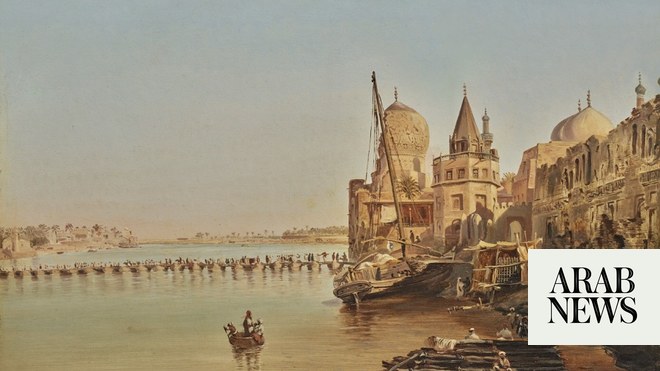
Here are some highlights from Sotheby’s 20th Century Art/Middle East sale, which takes place October 22 in London.
The famous auction house is billing this 1936 painting as “the most impressive example of Said’s landscapes ever to appear at auction” and predict it will fetch between $375,000 and $500,000.
Said is widely recognized as one of the most important figures in modern Egyptian art. His work combined elements of European art movements — from the Old Masters to post-impressionism — but retained a definite Egyptian feel, “capturing the Egyptian spirit during a time of intellectual renaissance.”
“After The Rain” was created during Said’s “Armana period,” and portrays an Egyptian countryside village — the backdrop to all of his paintings from this period — and another of his recurring motifs, a ripened palm tree. Sotheby’s particularly praises Said’s skill at “capturing the complexities of light to illustrate the depth of a sky as it is after rain — heavy clouds looming, yet with the hope of light and promise of sun,” and they way he uses the color of the sky to allude to the Nile — “his emblematic cobalt blue peppered with hints of turquoise and deeper, darker shades.”
Sotheby’s expects this 2016 piece from the Palestinian-Saudi Jeddah-based artist to fetch around $25,000 at the auction. The wood, copper and glass sculpture — which Awartani created with craftsmen in Morocco — is an excellent example of how her works “gently fuse the lineage of Islamic craftsmanship, its motifs and tessellations with contemporary practice” and, the auction house says, “encapsulates her contemporary approach to the age-old spiritual appreciation of geometry … marrying the precarious with the perfect.”
The hugely successful 43-year-old New York-based artist’s 2011 canvas is a typically striking display of Banisadr’s acclaimed technique. His work, Sotheby’s says “weaves together historical contexts — Islamic worlds meld with Medieval Europe with ease, and the gestural power of abstract impressionism is fused with battlegrounds from Persian miniatures.”
The auction house describes “Stardust” as “one of the most joyous works by the artist ever to appear at auction, the effervescent colors enveloping the viewer with a cosmic sense of harmony and serenity.” It is expected to fetch between $350,000 to $450,000.
Manoukian’s 1987 oil painting is part of the auction’s ‘Armenian Diaspora’ section, which “takes a look at the unique and multifaceted Armenian artistic heritage.”
“Through exile and war, many artists preserved their culture, history and language,” the auction brochure reads.
Manoukian spent much of the Lebanese Civil War in Beirut before moving to Los Angeles, where she now lives as a Buddhist nun. This work, which Sotheby’s expects to fetch between $12,000 to $15,000, is a self-portrait created soon after her move to Hollywood and depicts the loneliness and confusion she was feeling at the time. One of the artworks on the wall in the painting is a small watercolor painted by fellow Armenian diaspora artist Aroutyun Vartanian in 1950.
The Saudi army major and artist first conceived this large sculpture when his promotion led to him spend much of his time behind a desk stamping papers. On his website, Gharem explains that he was interested in how these stamps — “no matter how complex the logic that informed the thinking behind his decisions” — reduced everything to “a single stab, a binary ‘stamp’ or ‘no stamp.’”
He realized that, all across the Kingdom, every day, officials are slamming thousands of stamps down onto sheets of unrelated papers. “They articulate an unconscious and collective imprimatur, pronouncing what is right, what is acceptable, and which is the right path.”
The text on Gharem’s oversized stamp is short and to the point. “Have a bit of commitment,” it reads. Then, “Inshallah.” It is expected to fetch between $19,000 and $25,000 at auction.
The late painter and poet — sometimes referred to as ‘The Picasso of Iran’ — was known for the emotional power of his painting. His work in the 1960s, in particular, is disturbing and striking, offering, Sotheby’s says, a “host of dark, mythological characters used to express the anguish and despair of the huan condition.”
This oil painting from 1966 — expected to fetch between $150,000 and $225,000 — “encapsulates the artist’s unique ability to capture strength and vulnerability in the space of one canvas.”
The pioneering Lebanese abstract artist, who lived to the age of 100, was in her nineties before her work got any real exposure outside of Lebanon — becoming the first female Arab artist to have a solo show at London’s Tate Modern in 2013.
Choucair’s time in Paris just after the Second World War, absorbing the European avant-garde, informed much of her work. “Her aesthetic is shaped by, but not restricted to, Islamic geometry and calligraphy, colored with the daring palettes of her Parisian contemporaries and infused with the soft landscapes of Lebanon,” Sotheby’s explains. This 1949 work, estimated to be worth around $38,000 to $50,000, is the first of Choucair’s paintings to be available at auction.












